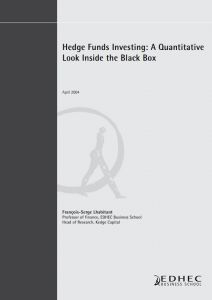

Hedge Funds Investing: A Quantitative Look Inside the Black Box
There is an increasing amount of evidence that shows the benefits of considering hedge funds as an asset class at the strategic asset allocation level. The investors’ greatest challenge remains the identification of desirable investment vehicles, since very little formal quantitative analysis of hedge funds has been done in the past. In this paper, we suggest an innovative approach to hedge fund investing, which is valid at the individual fund level as well as at the aggregate portfolio level (e.g. portfolio of hedge funds). This approach only relies on hedge funds historical returns. We provide several illustrations, including static and dynamic style analysis, benchmark construction, performance assessment, and value at risk calculations. A revisited version of this paper was published in the Journal of Financial Transformation µ, nº 1.
Author(s):
Summary:
There is an increasing amount of evidence that shows the benefits of considering hedge funds as an asset class at the strategic asset allocation level. The investors’ greatest challenge remains the identification of desirable investment vehicles, since very little formal quantitative analysis of hedge funds has been done in the past. In this paper, we suggest an innovative approach to hedge fund investing, which is valid at the individual fund level as well as at the aggregate portfolio level (e.g. portfolio of hedge funds). This approach only relies on hedge funds historical returns. We provide several illustrations, including static and dynamic style analysis, benchmark construction, performance assessment, and value at risk calculations. A revisited version of this paper was published in the Journal of Financial Transformation µ, nº 1.
Register to download PDF
Register/Log in| Type : | Working paper |
|---|---|
| Date : | 04/01/2004 |
| Keywords : |
Hedge Funds |

